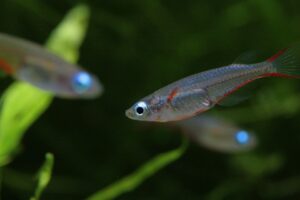
Introduction
Maintaining a healthy environment in your aquarium is crucial for the well-being of your aquatic life. One of the most common problems that aquarium enthusiasts face is the buildup of nitrates. High nitrate levels can lead to a host of issues, including stress, disease, and even death of the fish. Understanding how to effectively manage and reduce nitrate levels is essential for any aquarist. This article will explore the causes of high nitrate levels and offer practical tips to keep them under control.
Understanding Nitrates in Aquariums
Nitrates (NO3-) are a natural part of the nitrogen cycle in an aquarium. They are the end product of the breakdown of organic waste, such as uneaten food, fish excreta, and decaying plant material. Beneficial bacteria in the aquarium convert ammonia to nitrites (NO2-) and then to nitrates. While nitrates are less toxic than ammonia and nitrites, high levels can still harm fish and other aquatic organisms.
Typically, nitrate levels should be kept below 20 ppm (parts per million) in freshwater aquariums and even lower in reef and saltwater aquariums. Prolonged exposure to high nitrate levels can cause stress and weaken the immune systems of fish, making them more susceptible to disease.
Causes of High Nitrate Levels
Several factors can contribute to high nitrate levels in aquariums. Understanding these causes can help you develop a strategy to manage and reduce nitrates effectively.
Overfeeding
One of the most common causes of high nitrate levels is overfeeding. Excess food that is not consumed by the fish breaks down into waste, which contributes to nitrate buildup. Feeding your fish only what they can consume in a few minutes can significantly reduce the amount of uneaten food in the tank.
Overstocking
Having too many fish in a tank can lead to excessive waste production, overwhelming the aquarium’s biological filtration system. This results in higher nitrate levels. Ensuring your aquarium is not overstocked is a critical step in managing nitrate levels.
Inadequate Filtration
A filtration system that is not adequate for the size of the aquarium or the bioload can lead to an accumulation of nitrates. A good filtration system is essential for converting ammonia to nitrites and then to nitrates, and for removing these nitrates effectively.
Insufficient Water Changes
Regular water changes are crucial in removing nitrates from the aquarium. If water changes are not performed regularly, nitrates can accumulate to harmful levels. A consistent schedule for water changes can help keep nitrate levels in check.
Effective Tips to Reduce Nitrate Levels
Now that we understand the causes of high nitrate levels, let’s explore some effective strategies to reduce and manage them in your aquarium.
Regular Water Changes
Performing regular water changes is one of the most effective ways to reduce nitrate levels. Aim to change 10-15% of the water weekly, or 25-30% bi-weekly, depending on your tank’s bioload. This will help dilute the nitrates and maintain a healthier environment for your fish.
Use Nitrate-Absorbing Media
Many aquarium products on the market are specifically designed to absorb nitrates. Nitrate-absorbing resins or media can be placed in your filter to help reduce nitrate levels. These products can be an effective tool in maintaining low nitrate levels, especially in tanks with high bioloads.
Incorporate Live Plants
Live plants are natural nitrate consumers. They use nitrates as a nutrient source, helping to reduce levels in the aquarium. Fast-growing plants like hornwort, water sprite, and duckweed are particularly effective at absorbing nitrates. Incorporating live plants not only helps manage nitrates but also enhances the aesthetic appeal of your aquarium.
Reduce Feeding
As mentioned earlier, overfeeding is a significant contributor to high nitrate levels. Reducing the amount of food you provide and ensuring it is consumed within a few minutes can help minimize waste. Feed your fish small amounts, and monitor how much they consume to adjust portions accordingly.
Maintain a Balanced Stock
Ensure your aquarium is not overstocked. A balanced stocking level is crucial in managing waste production. Research the appropriate number of fish for your tank size and consider the specific needs of each species. Overstocking not only contributes to high nitrate levels but can also cause stress and aggression among fish.
Enhance Filtration
Upgrading or enhancing your aquarium’s filtration system can improve its efficiency in removing nitrates. Consider adding a protein skimmer, which is particularly useful in saltwater tanks, or upgrading to a more powerful filter that can handle a higher bioload. Ensure your filtration system is properly maintained and cleaned regularly to ensure optimal performance.
Consider a Deep Sand Bed (DSB)
In saltwater aquariums, a deep sand bed can be an effective method for nitrate reduction. A DSB provides an anaerobic environment where denitrifying bacteria can thrive. These bacteria convert nitrates into nitrogen gas, which is harmlessly released into the atmosphere. While setting up a DSB requires careful planning, it can be a long-term solution for nitrate management.
Use a Refugium
A refugium is a separate tank or compartment connected to the main aquarium, often used in saltwater systems. It can house macroalgae, which absorb nitrates, and provide a habitat for beneficial microorganisms. A refugium creates a more stable and balanced environment and can be a valuable addition to your aquarium setup.
Monitoring and Testing
Regular monitoring and testing of water parameters are essential in managing nitrate levels. Invest in a reliable aquarium test kit to measure nitrates, as well as ammonia, nitrites, pH, and other parameters. Testing your water regularly allows you to catch potential issues early and make necessary adjustments to maintain a healthy environment.
Conclusion
Reducing and managing nitrate levels in your aquarium is crucial for the health and well-being of your aquatic life. By understanding the causes of high nitrate levels and implementing the strategies outlined in this article, you can create a balanced and thriving environment for your fish and plants. Remember, consistency is key. Regular maintenance, careful monitoring, and a little effort will go a long way in ensuring your aquarium remains a healthy and vibrant ecosystem.
#ChatGPT assisted in the creation of this article.








